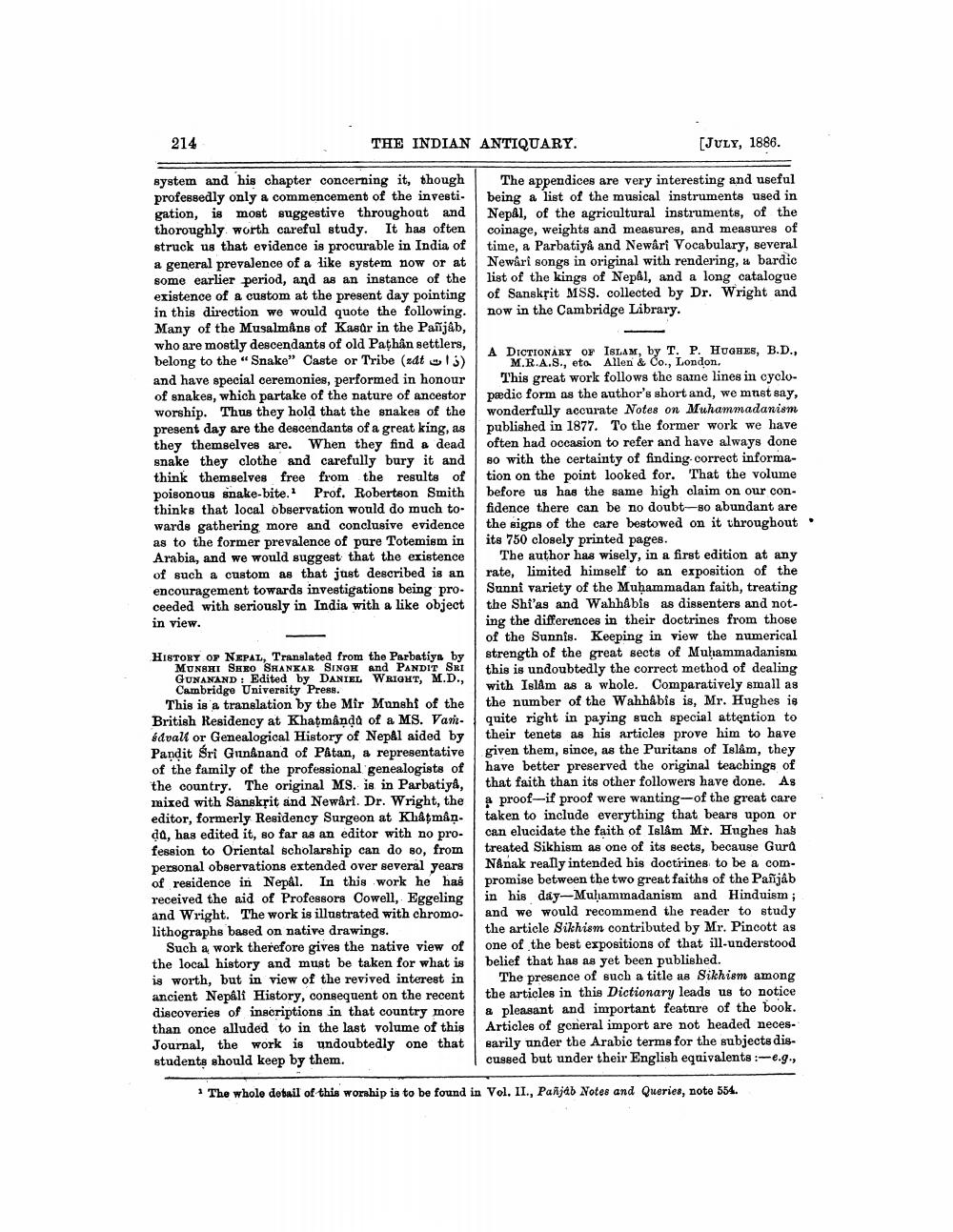________________
214
THE INDIAN ANTIQUARY.
[JULY, 1886.
system and his chapter concerning it, though The appendices are very interesting and useful professedly only a commencement of the investi. being a list of the musical instruments used in gation, is most suggestive throughout and Nepal, of the agricultural instruments, of the thoroughly worth careful study. It has often coinage, weights and measures, and measures of struck us that evidence is procurable in India of time, a Parbatiya and Newâri Vocabulary, severa a general prevalence of a like system now or at Newari songs in original with rendering, a bardic some earlier period, and as an instance of the list of the kings of Nepal, and a long catalogue existence of a custom at the present day pointing of Sanskrit MSS. collected by Dr. Wright and in this direction we would quote the following. now in the Cambridge Library. Many of the Musalmans of Kasar in the Pañjab, who are mostly descendants of old Pathân settlers,
A DICTIONARY OF ISLAM, by T. P. HUGHES, B.D., belong to the “Snake” Caste or Tribe (rdt ols)
M.R.A.S., eto, Allen & Co., London, and have special ceremonies, performed in honour This great work follows the same lines in cycloof snakes, which partake of the nature of ancestor pædic form as the author's short and, we must say, worship. Thus they hold that the snakes of the wonderfully accurate Notes on Muhammadanism present day are the descendants of a great king, as published in 1877. To the former work we have they themselves are. When they find a dead often had occasion to refer and have always done snake they clothe and carefully bury it and 80 with the certainty of finding correct informathink themselves free from the results of tion on the point looked for. That the volume poisonous snake bite. Prof. Robertson Smith before us has the same high claim on our conthinks that local observation would do much to fidence there can be no doubt-80 abundant are wards gathering more and conclusive evidence the signs of the care bestowed on it throughout as to the former prevalence of pure Totemism in its 750 closely printed pages. Arabia, and we would suggest that the existence! The author has wisely, in a first edition at any of such a custom as that just described is an rate, limited himself to an exposition of the encouragement towards investigations being pro. Sunni variety of the Muhammadan faith, treating ceeded with seriously in India with a like object the Shi'as and Wahhabis as dissenters and not. in view.
ing the differences in their doctrines from those
of the Sunnis. Keeping in view the numerical HISTORY OF NEPAL, Translated from the Parbatiys by strength of the great sects of Muhammadanism
MUNAHI SREO SHANKAR SINGH and PANDIT SRI this is undoubtedly the correct method of dealing GUNANAND: Edited by DANIEL WRIGHT, M.D., Cambridge University Press.
with Islam as a whole. Comparatively small as This is a translation by the Mir Munshf of the the number of the Wahhabis is, Mr. Hughes is British Residency at Khatmândů of a MS. Van quite right in paying such special attention to édvalt or Genealogical History of Nepal aided by their tenets as his articles prove him to have Pandit Sri Gunanand of Patan, a representative given them, since, as the Puritans of Islam, they of the family of the professional genealogists of have better preserved the original teachings of the country. The original MS. is in Parbatiya, that faith than its other followers have done. As mixed with Sanskțit and Newari. Dr. Wright, the proof-if proof were wanting of the great care editor, formerly Residency Surgeon at Kh&tmån. taken to include everything that bears upon or da, has edited it, so far as an editor with no pro- can elucidate the faith of Islâm Mr. Hughes has fession to Oriental scholarship can do so, from treated Sikhism as one of its sects, because Gura personal observations extended over several years
Nának really intended his doctí'ines to be a comof residence in Nepal. In this work he has promise between the two great faiths of the Pañjab received the aid of Professors Cowell, Eggeling in his day-Muhammadanism and Hinduism ; and Wright. The work is illustrated with chromo. and we would recommend the reader to study lithographs based on native drawings.
the article Sikhism contributed by Mr. Pincott as Such a work therefore gives the native view of one of the best expositions of that ill-understood the local history and must be taken for what is belief that has as yet been published. is worth, but in view of the revived interest in The presence of such a title as Sikhism among ancient Nepali History, consequent on the recent the articles in this Dictionary leads us to notice discoveries of inscriptions in that country more & pleasant and important feature of the book. than once alluded to in the last volume of this Articles of general import are not headed necesJournal, the work is undoubtedly one that sarily under the Arabie terms for the subjects disstudents should keep by them.
cussed but under their English equivalents :-.g.,
* The whole detail of this worship is to be found in Vol. II., Panjab Notes and Queries, note 554.




